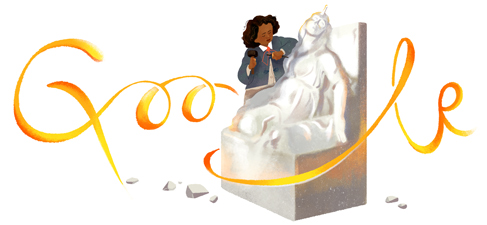General Discussion
Related: Editorials & Other Articles, Issue Forums, Alliance Forums, Region Forumsgoogle doodle celebrates edmonia lewis-AA and native american sculptor
Edmonia Lewis


Born Edmonia Lewis
c. July 4, 1844
Greenbush, New York, United States
Died September 17, 1907 (aged 63)
London, England, United Kingdom
Nationality American
Education Oberlin College
Known for Sculpture
Movement Neoclassicism
Patron(s) Ulysses S. Grant
Mary Edmonia Lewis (c. July 4, 1844 – September 17, 1907) was an American sculptor who worked for most of her career in Rome, Italy. She was the first woman of African-American and Native American heritage to achieve international fame and recognition as a sculptor in the fine arts world. Her work is known for incorporating themes relating to black people and indigenous peoples of the Americas into Neoclassical style sculpture. She began to gain prominence during the American Civil War, and by the end of the 19th century, she was the only black woman who had participated in and been recognized to any degree by the American artistic mainstream. In 2002, the scholar Molefi Kete Asante listed Edmonia Lewis on his list of 100 Greatest African Americans.[1]
Edmonia Lewis's birth date has been listed as July 4, 1844. She was born in Greenbush, New York, which is now the city of Rensselaer.[2] Her father was an Afro-Haitian, while her mother was of Mississauga Ojibwe and African-American descent.[3] Lewis's mother was known as an excellent weaver and craftswoman, while her father was a gentleman's servant.[4][5] Her family background inspired Lewis in her later work. By the time Lewis reached the age of nine, both of her parents had died. Her father died in 1847.[6] Her two maternal aunts adopted her and her older half-brother Samuel. Samuel was born in 1835 to Lewis's father and his first wife in Haiti. The family came to the United States when Samuel was a young child.[6] Samuel became a barber at age 12 when his father died.[6]
. . . . .


After college, Lewis moved to Boston in early 1864, where she began to pursue her career as a sculptor. The Keeps wrote a letter of introduction on Lewis' behalf to William Lloyd Garrison in Boston, and he was able to introduce her to already established sculptors in the area, as well as writers who then publicized Lewis in the abolitionist press.[16] Finding an instructor, however, was not easy for Lewis. Three male sculptors refused to instruct her before she was introduced to the moderately successful sculptor Edward A. Brackett (1818–1908),[17] who specialized in marble portrait busts.[18][19] His clients were some of the most important abolitionists of the day including Henry Wadsworth Longfellow, William Lloyd Garrison, Charles Sumner, and John Brown.[18] To instruct her, he lent her fragments of sculptures to copy in clay, which he then critiqued.[19] Under his tutelage, she crafted her own sculpting tools and sold her first piece, a sculpture of a woman’s hand, for $8.[20] Anne Whitney, a fellow sculptor and friend of Lewis', wrote in an 1864 letter to her sister that her relationship with her instructor did not end amicably. The reason for the split, however, was never mentioned.[18] Lewis opened her studio to the public in her first solo exhibition in 1864.[21]
Lewis was inspired by the lives of abolitionists and Civil War heroes. Her subjects in 1863 and 1864 included some of the most famous abolitionists of her day: John Brown and Colonel Robert Gould Shaw.[22] When she met Union Colonel Robert Gould Shaw, the commander of an African American Civil War regiment from Massachusetts, she was inspired to create a bust of his likeness, which impressed the Shaw family, who purchased her homage.[23] Lewis then made plaster cast reproductions of the bust; she sold one hundred at 15 dollars apiece.[24] Anna Quincy Waterston, a poet, then wrote a poem about both Lewis and Shaw.[25] From 1864 to 1871, Lewis was written about or interviewed by Lydia Maria Child, Elizabeth Peabody, Anna Quincy Waterston, and Laura Curtis Bullard. These were all important women in Boston and New York abolitionist circles.[18] Because of these women, articles about Lewis appeared in important abolitionist journals including Broken Fetter, the Christian Register, and the Independent, as well as many others.[22] Lewis was perceptive to her reception in Boston. She was not opposed to the coverage she received in the abolitionist press, and she was not known to deny monetary aid, but she could not tolerate the false praise. She knew that some did not really appreciate her art, but saw her as an opportunity to express and show their support for human rights.[26]
. . . .
https://en.wikipedia.org/wiki/Edmonia_Lewis
Quiet_Dem_Mom
(599 posts)This podcast has quite an archive of episodes, too, if you're a history buff / podcast fan.
